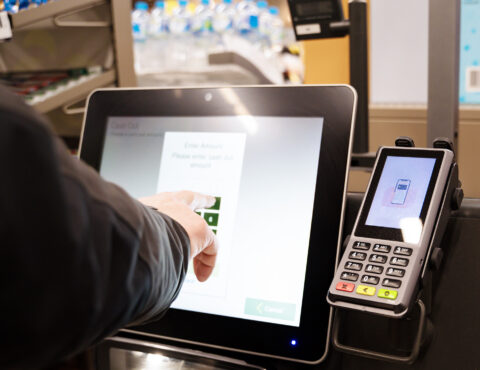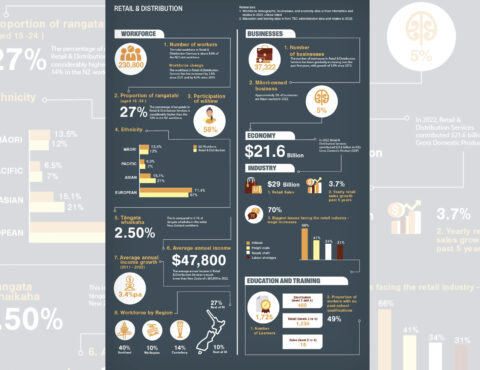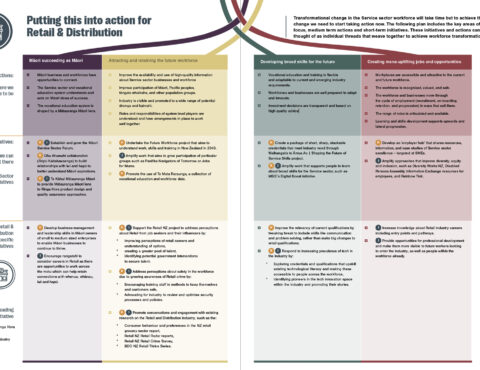Ringa Hora has worked with people from across industry to develop a shared roadmap to transform the Service sector workforce from its current state to the future that we aspire to.
The Workforce Development Plan looks across the Service sector and sets out the major factors shaping the sector and an overarching vision for the future.
Against that context, this Action Plan focuses on the characteristics and dynamics of the Retail & Distribution industry and its workforce. It describes what the future could look like for this workforce, the current challenges faced by the industry, and sets out the actions we can take to tackle this wero | challenge.
Ringa Hora’s Service Sector Workforce Development Plan is based on four aho | strands. Each of these aho will strengthen the workforce, but when woven together, as a taura whiri | rope, we can achieve real transformation of the workforce:
The Retail & Distribution industry will always offer a variety of opportunities for kaimahi. We can see that a growth in Māori-owned businesses and iwi influence (as commercial property owners) means the future will provide more people with the opportunity to work in or own businesses built on Te Ao Māori values. For example, we’ve heard from Māori retail business owners that their ‘why’ is entwined with empowering the mana of wāhine and “helping others to find expression through culture”.1
This is a future where more kaimahi have opportunities to up-skill in much needed areas so they are able to embrace on-going innovations that are characteristic of the industry (such as adapting to technological advances and changing consumer expectations). Skill development supports the effective and efficient delivery of operations plus can reduce turnover by helping smooth the pathways for people to move across, upwards, and beyond the industry.

The Retail & Distribution industry refers to the wholesale and retail of a range of products through an online presence or traditional ‘bricks and mortar’ premises.
Whether it’s a business providing goods such as food and clothing to people and whānau across the country, or a wholesaler supplying businesses as part of the supply chain, the Retail & Distribution industry is at the heart of these transactions.
The industry has a large proportion of small businesses, however, there are also a number of big box retailers which are some of New Zealand’s largest employers. The industry also connects Aotearoa to the rest of the world and its international markets, while also showcasing local products.

To help us get to the future state, we need to understand and tackle the challenges that the Retail & Distribution sector faces, while also seizing the opportunities that already exist or are on the horizon. We’ve heard that the factors having a significant impact on the Retail & Distribution industry and its approach to workforce development include rising inflation and wage increases, a shortage of labour exacerbated by high turnover, technological advances and changing consumer demands, and rising retail crime.
Addressing labour shortages paired with a high turnover
Labour shortages are a huge challenge in the Retail & Distribution industry as businesses struggle to get enough workers through the door to meet today’s consumer demand. This is exacerbated by a very high turnover which negates many recruitment efforts by industry. Even pre-COVID-19, the industry typically lost 50% of its staff within 12 months of entering the industry. For example, although 58,000 new workers joined the Retail & Distribution industry in 2018, only 25,000 remained a year later.
Recognising the impact of inflation and wage increases
Inflationary pressures have meant that many retailers are experiencing declines in sales in-store and online. For workers this means there has been a significant pressure on retail wages over the last few years. Within Retail & Distribution, the grocery and supermarket industry is a clear example of these issues as a ‘public face’ of the cost-of-living crisis in New Zealand and as one of the first tests for newly introduced Fair Pay Agreements.
Preparing the industry for technological advances and changing customer demands
The COVID-19 pandemic highlighted the benefits of online shopping and the trend towards multi-channel retail experiences is likely to continue. Other changing consumer preferences and technological changes (such as the use of QR codes, non-standard business hours, or innovations in payment methods) highlight the need for companies to upskill staff so they can better understand and improve the end-to-end journey of the customer experience.
Keeping customers and the workforce safe in the face of retail crime
Retail crime (such as ramraids, theft and vandalism) is estimated to cost $2.6 billion per year. The preventative and response measures increase the cost of business and may change the types of skills and attributes that retailers value – for example, the workforce needs to be able to adapt to new safety measures de-escalate conflict, and be aware of cyber-crime.
With 230,800 employees, the Retail & Distribution workforce accounts for approximately 8.6% of the total New Zealand workforce; with at least 30,000 people employed in leadership and management roles such as general retail management, chief executive, sales and marketing, and office management.
The industry offers workers countless opportunities to grow transferrable skills that support and shape people’s career pathways within and outside of the industry.
The industry is an important entry point to the wider workforce for many young people. More than a quarter of the Retail & Distribution workforce are aged between 15- 24 years old. This age profile can explain why half of the workforce has no post-school qualifications, which is higher than the national average by 12%. However, not all new starters are rangatahi in secondary school or taking on their first job. The highest proportion of entrants into the Retail and Distribution industry are career changers (45%), followed by tertiary students (23%). Therefore, it is important to recognise the skills and experience that workers bring with them from other roles and industries.
New Zealanders are increasingly diverse. Embracing and celebrating diversity makes businesses more attractive to potential kaimahi and customers, as well as creating economic and social benefits for employers, the workforce, and the wider community.
Using workforce participation data as a starting point shows that there is work to be done in the Retail & Distribution Services industry to realise the aspirations and potential of Māori, Pacific peoples, and tāngata whaikaha | disabled people:
![]()
It is important Māori feel reflected within the industry. We are anticipating a significant growth of Māori business across the Service Sector, including Retail & Distribution. Currently, Māori owned businesses in the industry account for 5% of businesses. These businesses often take a whānau approach, supporting and empowering Māori to succeed as Māori. In addition, iwi are shaping the physical retail landscape across Aotearoa as owners of large commercial developments.
![]()
The Retail & Distribution industry accounts for nearly a quarter of all Pacific peoples employed in the service sector. Pacific peoples tend to be employed more in distribution rather than on the retail floor. Insights from the industry suggest that the number of Pacific peoples in management or leadership roles is marginal, with this pathway quite limited and varied. Developing and upskilling the Pacific workforce already in the industry will help retain and create pathways for workers to progress into leadership and management roles.
![]()
Tāngata whaikaha includes physical, mental, intellectual, or sensory impairments which can impact a person’s life to varying degrees and in different ways. We acknowledge that data on tāngata whaikaha is limited, and it is important that we create more growth opportunities within the sector for our tāngata whaikaha workforce.

Explore Retail & Distribution industry workforce demographic, business, and economy statistics, and education and training data.

Transformational change in the Service sector workforce will take time but to achieve that change we need to start taking action now. The Retail & Distribution action plan includes the key areas of focus, medium-term actions and short-term initiatives. These initiatives and actions can be thought of as individual threads that weave together to achieve workforce transformation.